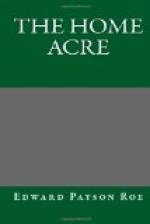The canker-worm in those localities where it is destructive can be guarded against by bands of tar-covered canvas around the trees. The moth cannot fly, but crawls up the tree in the late autumn and during mild spells in winter, but especially throughout the spring until May. When, the evil-disposed moth meets the ’tarry band he finds no thoroughfare, and is either caught or compelled to seek some other arena of mischief.
We have all seen the flaunting, unsightly abodes of the tent caterpillar and the foliage-denuded branches about them. Fortunately these are not stealthy enemies, and the owner can scarcely see his acre at all without being aware of their presence. He has only to look very early in the morning or late in the evening to find them all bunched up in their nests. These should be taken down and destroyed.
Cherry and pear slugs, “small, slimy, dark brown worms,” can be destroyed by dusting the trees with dry wood ashes or air-slacked lime.
Field-mice often girdle young trees, especially during the winter, working beneath the snow. Unless heaps of rubbish are left here and there as shelter for these little pests, one or two good cats will keep the acre free of them. Treading the snow compactly around the tree is also practiced.
Do not let the reader be discouraged by this list of the most common enemies, or by hearing of others. After reading some medical works we are led to wonder that the human race does not speedily die out. As a rule, however, with moderate care, most of us are able to say, “I’m pretty well, I thank you,” and when ailing we do not straightway despair. In spite of all enemies and drawbacks, fruit is becoming more plentiful every year. If one man can raise it, so can another.




